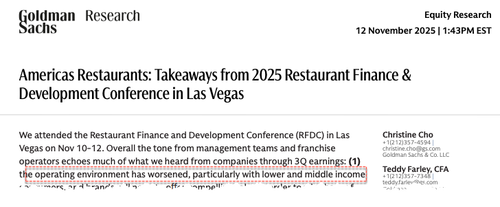Goldman analysts led by Christine Cho attended the Restaurant Finance & Development Conference (RFDC) in Las Vegas earlier this week. The conference drew restaurant executives and founders, franchisees and multi-unit operators, private-equity investors and lenders, industry consultants, and other stakeholders across the broader restaurant ecosystem.
Cho and her team met with many of these restaurant industry insiders and heard a very alarming and consistent message: the operating environment is deteriorating, especially among lower- and middle-income consumers, pushing brands to use discount campaigns to defend market share.
She said there was also increasing discussion around accelerating AI adoption, with operators betting on hybrid human-AI models to reduce costs and improve service.
Cho's takeaways from RFDC are extensive and offer new color into the health of the restaurant industry and, by extension, the consumer. ZeroHedge Pro subscribers can find the complete list of takeaways in the usual place.
In this note, we're focusing on just two of the takeaways. The first is the alarming shift among low- and middle-income consumers who are increasingly giving up on eating out and instead buying groceries and eating at home:
- Also noted was the drag on restaurant traffic by non-restaurants, particularly grocery and c-stores. A combination of data and surveys indicate growing evidence that consumers are leaving fast food and fast casual restaurants, replacing the meals with a combination of grocery (Aldi and Trader Joe's specifically highlighted as taking share), fresh format grocery (for example, the hot food bar at Whole Foods), and c-store food (particularly with breakfast).
The second takeaway that caught our attention is the coming automation tidal wave that's about to sweep through the restaurant industry:
For the second year in a row, AI was front and center at the conference, with the focus split between current applications of AI and potential future developments across the restaurant space.
Central to the discussion on current applications of AI was the focus on leveraging the technology to enhance the customer experience. Experts from both the restaurant industry and technology industry believe that it is not a case of robots fully replacing humans, but rather a hybrid approach by which humans leverage AI to drive efficiency gains and redirect their time and effort to other tasks that are more critical to the customer. From the perspective of a restaurant general manager, AI can help inform and expedite critical decisions around labor scheduling, inventory management, and food prep timing, and can also be leveraged to help train the workforce (seen as particularly critical given that it is a high turnover industry). Voice AI in the drive thru was also highlighted as a strong use case, with operators noting that is performing well in their tests.
Given these findings, let's build on yesterday's UBS note from analyst Jonathan Pingle, which highlights a tale of two consumer worlds…
And it gets worse.
Financial strains are building among low-income, millennial, and Gen-Z consumers, suggesting the Trump administration will likely push an affordability agenda into hyperdrive (read here) to prevent younger and lower-income voters from drifting toward the new unhinged Democratic Party that has been seized by Marxist DSA-ers, which will be dangling "free stuff" heading into next year's midterm elections.
Loading recommendations...

